
Wine Culture and Information since 2002 - Volume 22
 Wine Culture and Information since 2002 - Volume 22 |
|
The Narration of Wine TastingThe narration of wine tasting has many goals, not only for personal pleasure, but also for defining its qualities through critical and analytical tasting |
|
Tasting is not the “natural” destination of a wine or, better to say, wine was not “invented” for this purpose. It is very likely the first vintners and wine makers of history did not pay much attention of its tasting in a critical or analytical way. They were probably happy with the magic produced by fermentation, a mysterious phenomenon for centuries however capable of turning grape juice into wine, they were simply happy for drinking a liquid that, among the many things, had the quality of cheering thoughts up. Maybe critical wine tasting was born when the same person had the chance to drink two different wines at the same time: he will unavoidably compared the content of his cup and decided - according to his taste - which of the two was better. Comparison, a ruthless act and most of the times decisive, marks a border line among things, unavoidably forcing people to decide, or to choose, the best and the worse. With time and with the possibility of tasting wines from different areas - fundamental the development of trading routes - comparison has become more and more ruthless and difficult. It was not just a simple matter of deciding what wine was the best, but to understand the reason why a wine was better than others. They realized wines from specific areas had superior qualities than others. These wines become very popular and in much demand, contributing to the economic development of those areas and, with that, the development of viticulture and wine making of those lands. A rule which, in general terms, is still true today: whoever makes quality has the interest of improving products in order to stand comparison and competition which, of course, moves on. Competition which, unavoidably, also arises inside the same area, has the positive side effect of improving the quality of the whole territory. Wine gets different meaning according to the moment and the context of tasting as well as the goal of tasting. We should not forget wine is - first of all - a beverage which has always witnessed, in the course of its history, the celebration of communion and of socialization. A beverage to celebrate friendship and having good time in good company, a mean for socialization and aggregation, wine has always been found in the tables of all times. The respect for wine has been so high that, in the course of its history, it has been the protagonist of significant ritual moments, not only of religious nature, but also social and solemn ones. But also less “formal” moments - however highly significative - in which wine simply played the role of refreshing and corroborant beverage for farmers working under the heat of sun rays, humble and worth companion of the table and of food. Wine, in the course of its history, has become what every social class wanted it to be. Humble however important to many, considered as food; a way to show off their power and prestige for few ones. Sensorial tasting of wine follows, for many aspects, this model. There is who tastes wine only to determine whether he or she likes it, others like to give wine words full of images - that in many cases, talk about everything but wine - and use the exercise of tasting as a mean of self-celebration just to show people he or she is “the best”. Moreover, there is also who tastes a wine in a detached way, only interested to its sensorial qualities in order to analyze it. They are different methods and ways, having different goals as well, however having the fundamental subject of wine and its chemical, organoleptic, sensorial and emotional qualities. Of course, there are also are “in between” ways of tasting a wine, more moderate and less extremist.
Each one of these methods of considering wine is however useful to understanding and communicating wine. It depends on who will be reading and on what one expects to find in a wine. In other words, depends on what wine represents for each one of us. Some are only interested to technical aspects, finding very useful the sensorial indication about specific aromas and flavors, signals of the presence of certain grapes, qualities and faults, specific environmental conditions, wine making techniques, possible alterations or adulterations. Others are attracted by the idea that, by tasting a specific wine, they will feel like being “in an uncontaminated beach, delighted by the smell of the sea and by seagulls perching on their shoulders, in a sunny day at the sunset, cherished by the symphony of waves dashing on the reef”. In this sense, wine is an expression of freedom: everyone sees or look for what it is more similar to one's own character, emotions and interests. A wine maker, for example, will be scarcely interested to the imaginative description of a wine. According to a technical point of view, knowing a wine is “straight and deep, with sprightly tannins, a turgid and crunchy fruit inviting to the unquenchable thirst, never taken for granted, proud like a mighty warrior in the battle field circling his shiny sword of fury and everlasting glory” (a completely imaginary description, taken as an example, probably extreme, of this style) does not tell anything about that wine. A description like that may have a wine maker feel very proud for having created - even with a certain astonishment - such a mighty wine, but it certainly does not tell anything about the technical qualities of his wine. A technician is interested to know if the wine has an aroma of bell pepper: not just for knowing about the presence of this vegetable; indeed as a signal for the presence of 2-methoxy-3-isobutylpyrazine. This is in fact one of the organic compounds recalling the aroma of green bell pepper and that in certain grapes is common - such as Cabernet Franc and Sauvignon Blanc, when harvested not completely ripe and in cold climates - whereas in other grapes it is the sign of a fault or lack of correspondence. The same description - more emotional, not technical at all - will be attracting and communicative for the average consumer and for wine lovers in general. To know in wines produced with Chardonnay grape it is normal to find acetate isoamyle, responsible for the aroma of banana, can be for many something not communicative at all, indeed, this can be quite confusing and with the effect of disorienting a consumer. The two ways of communicating a wine are however useful and worth at the same way: it depends on whom they are destined to. Of course, this is true as long as one does not exaggerate with a description or does that with goals different from the “narration of wine”. A less noble thing is self-celebration: using wine as a mean for showing off a supposed competence or superiority, is something tedious having nothing to do with the narration of wine and with wine culture. What is wine tasting for? Some believe it is a refined, and somewhat spectacular, exercise of fiction, in which the taster shows off an evocative vocabulary full of adjectives and substantives, by telling aromas and flavors no one else perceives but him, or pretends to perceive. Others believe it is a very serious task, an analytical investigation by using senses and with the goal of understanding wine qualities, its territory, production characteristics, correspondence to type and determination of quality in general terms. Personal evaluation and conditioning unavoidably take part to the process of tasting - despite its goal - a factor becoming less and less influential with the increasing of professionalism and experience of the taster. Both definitions, although being opposed one to each other, can be considered true. There are some who simulate something and some who are serious, as well as some who improvise and some who are competent, as in life, as in a game. As the narration of wine seems to be quite subjective, evocative, filtered in function of one's own interests and way of telling about a wine, some of you could ask whether there is a truly objective and reliable way to do that. The answer could be simple and obvious: chemical analysis and gas chromatography. By using chemical analysis it is possible to determine the presence and the quantity of substances in a wine, whereas gas chromatography allows the determination of the presence and quantity of volatile substances, in other words, its aromas. This is in fact the method used by laboratories of analysis - as well as in wineries, which frequently have an internal laboratory of analysis - in order to determine the presence and the quantity of organic compounds in a wine. The result of the analysis makes it possible to know, exactly, the composition of a wine and its correspondence to the varieties used and stated, nature of faults and qualities. This type of approach could be considered as the ultimate solution to the narration of wine. The result could end every controversy about a wine: by saying in a wine can be perceived the aroma of banana when - by reading a chemical analysis - there was no trace of acetate isoamyle, this would make that narration useless and not reliable at all. However, things are not so easy as they seem, in particular because the aroma of banana is not determined by acetate isoamyle only, although this is the main component. Chemical analysis of a wine determines in fact the presence and the quantity of substances found in it, something very different from sensorial perception. Taste and senses, as well as emotions, are not just based on the presence and quantity of stimuli making them. It is an extremely complex relation, in which the interaction, intensity and strength of each stimulus - flavors, aromas and tactile perceptions - contribute to create the taste as an unique sensorial phenomenon. It is not enough to know in a food or in a beverage is found sugar to define it as sweet. This depends on the quantity in function of the other substances found in the food or the beverage. For example, in case sugar is found in excessive quantity, the stimulus we perceive will certainly be sweet, but also cloying, therefore losing its pleasantness. The perception of good taste - as well as of a good smell - is therefore determined by a condition which can be hardly determined in an analytical and chemical way: balance. Harmony among the many stimuli and their relation is impossible to define in a “scientific” way, as each one of us have his own reference of perception, as well as sensitivity and tolerance, to the pleasantness of each stimulus. Everyone has his own taste. We can maybe define a concept of objective balance, but this cannot be considered as an absolute rule, valid for everyone. For example, there are some who love Pinot Noir, and others who hate it, some believe Merlot is the best grape in the world, and others who believe it is just a very easy grape not much expressive. There is not a right way and a wrong way to describe a wine, as well as there is not a right way and a wrong way to taste a wine and to do a sensorial tasting. It always depends on the type of result one wants to achieve and, in particular, the destination of the tasting. Absolute rules do not exist, likewise, the best wine does not exist as well. The best one does not exist. An extremely relative concept and too much subjective, the definition of the “best” obeys to this principle. Everyone of us have its own “best one”, everyone has his or her preferred wine, everyone has a preferred way to narrate a wine, as well as each one of us have its way to listen to a wine and to its narration. In other words, the narration of wine obeys to the most fundamental rules of communication. It takes one who narrates it, someone who listens to it and - in order to be truly effective - it must be used a common language, a language both can understand, and, in particular, both can feel.
|
||||||||||||
Wines of the Month |
|
|
|
Score legend Prices are to be considered as indicative. Prices may vary according to the country or the shop where wines are bought |
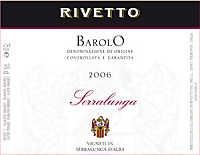
|
|
Barolo Serralunga 2006 |
|
| Rivetto (Piedmont, Italy) | |
| Grapes: Nebbiolo | |
| Price: € 29.00 | Score: |
| Barolo Serralunga shows a brilliant ruby red color and nuances of brick red, moderate transparency. The nose reveals intense, clean, pleasing, refined and elegant aromas which start with hints of cherry, plum and violet followed by aromas of raspberry, pomegranate, vanilla, chocolate, cinnamon, mace and menthol. The mouth has good correspondence to the nose, a tannic attack and however balanced by alcohol, full body, intense flavors, pleasing crispness. The finish is persistent with flavors of cherry, plum and pomegranate. Barolo Serralunga ages for 32 months in cask followed by 10 months of aging in bottle. | |
| Food Match: Game, Roasted meat, Stewed and braised meat, Hard cheese | |
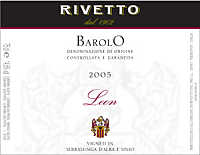
|
|
Barolo Leon 2005 |
|
| Rivetto (Piedmont, Italy) | |
| Grapes: Nebbiolo | |
| Price: € 36.00 | Score: |
| Barolo Leon shows an intense ruby red color and nuances of brick red, moderate transparency. The nose reveals intense, clean, pleasing, refined and elegant aromas that start with hints of cherry, plum and dried violet followed by aromas of blueberry, rose, vanilla, raspberry, tobacco, licorice, chocolate, cinnamon, mace and menthol. The mouth has good correspondence to the nose, a tannic attack and however balanced by alcohol, full body, intense flavors, pleasing crispness. The finish is persistent with flavors of cherry, plum and raspberry. Barolo Leon ages for 36 months in cask and in barrique followed by 14 months of aging in bottle. | |
| Food Match: Game, Roasted meat, Braised and stewed meat, Hard cheese | |
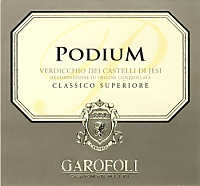
|
|
Verdicchio dei Castelli di Jesi Classico Superiore Podium 2008 |
|
| Garofoli (Marches, Italy) | |
| Grapes: Verdicchio | |
| Price: € 11.50 | Score: |
| Verdicchio dei Castelli di Jesi Classico Superiore Podium shows an intense straw yellow color and nuances of straw yellow, very transparent. The nose reveals intense, clean, pleasing, refined and elegant aromas that start with hints of apple, plum and peach followed by aromas of hawthorn, jasmine, citrus fruits, anise, pineapple, almond, broom, pear and mineral. The mouth has excellent correspondence to the nose, a crisp attack and however balanced by alcohol, good body, intense flavors, pleasing roundness. The finish is very persistent with long flavors of plum, apple and almond. Verdicchio dei Castelli di Jesi Classico Superiore Podium ages for 15 months in steel tanks followed by 4 months of aging in bottle. | |
| Food Match: Roasted fish, Stuffed pasta, Stewed fish, Roasted white meat | |
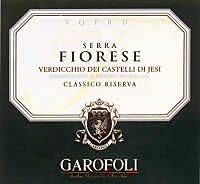
|
|
Verdicchio dei Castelli di Jesi Classico Superiore Riserva Serra Fiorese 2006 |
|
| Garofoli (Marches, Italy) | |
| Grapes: Verdicchio | |
| Price: € 13.50 | Score: |
| Verdicchio dei Castelli di Jesi Classico Superiore Riserva Serra Fiorese shows a brilliant golden yellow color and nuances of straw yellow, very transparent. The nose reveals intense, clean, pleasing, refined and elegant aromas which start with hints of apple, plum and almond followed by aromas of pineapple, pear, anise, vanilla, hawthorn, peach, grapefruit, broom and mineral. The mouth has excellent correspondence to the nose, a crisp attack and however balanced by alcohol, good body, intense flavors, pleasing roundness. The finish is very persistent with long flavors of apple, plum and almond. Verdicchio dei Castelli di Jesi Classico Superiore Riserva Serra Fiorese ages for 11 months in barrique followed by at least 12 months of aging in bottle. | |
| Food Match: Roasted fish, Roasted white meat, Stewed fish, Stuffed pasta with mushrooms | |
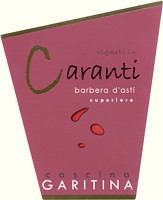
|
|
Barbera d'Asti Superiore Caranti 2008 |
|
| Cascina Garitina (Piedmont, Italy) | |
| Grapes: Barbera | |
| Price: € 9.50 | Score: |
| Barbera d'Asti Superiore Caranti shows an intense ruby red color and nuances of ruby red, little transparency. The nose reveals intense, clean, pleasing and refined aromas which start with hints of cherry, plum and violet followed by aromas of blueberry, blackberry, vanilla, mace, geranium and pink pepper. The mouth has good correspondence to the nose, a slightly tannic attack and however balanced by alcohol, good body, intense flavors, pleasing crispness. The finish is persistent with flavors of cherry, plum and blueberry. Barbera d'Asti Superiore Caranti ages in cask for 13 months followed by at least 3 months of aging in bottle. | |
| Food Match: Roasted meat, Broiled meat and barbecue, Stewed meat, Hard cheese | |
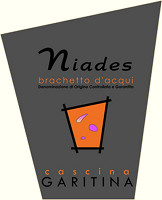
|
|
Brachetto d'Acqui Niades 2010 |
|
| Cascina Garitina (Piedmont, Italy) | |
| Grapes: Brachetto | |
| Price: € 10.00 | Score: |
| Brachetto d'Acqui Niades shows a pale ruby red color and nuances of cherry pink, moderate transparency. The nose reveals intense, clean, pleasing and refined aromas which start with hints of strawberry, rose and grape followed by aromas of raspberry, cherry, carnation, blackberry, cyclamen and blueberry. The mouth has good correspondence to the nose, a sweet and crisp attack, however balanced by alcohol, light body, intense flavors, pleasing effervescence. The finish is persistent with flavors of grape, strawberry and cherry. Brachetto d'Acqui Niades ferments at low temperature in fridge for about 10 days. | |
| Food Match: Semifreddo, Fruit desserts | |
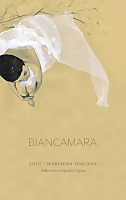
|
|
Biancamara 2010 |
|
| Pieve Vecchia (Tuscany, Italy) | |
| Grapes: Chardonnay, Fiano | |
| Price: € 8.00 | Score: |
| Biancamara shows a pale straw yellow color and nuances of greenish yellow, very transparent. The nose denotes intense, clean, pleasing and refined aromas that start with hints of peach, banana and pear followed by aromas of hawthorn, acacia, broom, apple and hints of vanilla. The mouth has good correspondence to the nose, a crisp attack and however balanced by alcohol, good body, intense flavors, agreeable. The finish is persistent with flavors of banana, pear and peach. Biancamara ages for 3 months in cask. | |
| Food Match: Pasta with fish, Broiled crustaceans, Vegetable soups, Sauteed fish | |

|
|
Pieve dei Monaci 2008 |
|
| Pieve Vecchia (Tuscany, Italy) | |
| Grapes: Syrah | |
| Price: € 10.00 | Score: |
| Pieve dei Monaci shows an intense ruby red color and nuances of ruby red, little transparency. The nose denotes intense, clean, pleasing and refined aromas which start with hints of black currant, black cherry and plum followed by aromas of blueberry, violet, vanilla, tobacco, chocolate and menthol. The mouth has good correspondence to the nose, a tannic attack and however balanced by alcohol, good body, intense flavors, pleasing roundness. The finish is persistent with flavors of black currant, black cherry and plum. Pieve dei Monaci ages in cask for 6 months. | |
| Food Match: Broiled meat and barbecue, Roasted meat, Stewed meat, Hard cheese | |
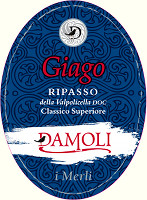
|
|
Valpolicella Classico Superiore Ripasso Giago 2007 |
|
| Damoli (Veneto, Italy) | |
| Grapes: Corvinone (40%), Corvina (30%), Rondinella (30%) | |
| Price: € 14.30 | Score: |
| Valpolicella Classico Superiore Ripasso Giago shows an intense ruby red color and nuances of garnet red, little transparency. The nose reveals intense, clean, pleasing and refined aromas which start with hints of black cherry, blackberry and plum followed by aromas of blueberry, dried violet, vanilla, tobacco, cocoa and menthol. The mouth has good correspondence to the nose, a slightly tannic attack and however balanced by alcohol, good body, intense flavors, pleasing roundness. The finish is persistent with flavors of black cherry, blackberry and plum. A part of Valpolicella Classico Superiore Ripasso Giago ages for 3 years in cask and the remaining part in barrique. | |
| Food Match: Roasted meat, Broiled meat and barbecue, Stewed and braised meat with mushrooms, Hard cheese | |
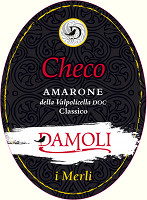
|
|
Amarone della Valpolicella Classico Checo 2005 |
|
| Damoli (Veneto, Italy) | |
| Grapes: Corvinone (45%), Corvina (30%), Rondinella (25%) | |
| Price: € 35.30 | Score: |
| Amarone della Valpolicella Classico Checo shows an intense ruby red color and nuances of garnet red, little transparency. The nose reveals intense, clean, pleasing and refined aromas which start with hints of blackberry, plum and dried violet followed by aromas of black cherry, blueberry, vanilla, chocolate, cinnamon, tobacco, mace and menthol. The mouth has good correspondence to the nose, a tannic attack and however balanced by alcohol, full body, intense flavors, pleasing roundness. The finish is persistent with flavors of blackberry, plum and black cherry. Amarone della Valpolicella Classico Checo ages for 5 years in cask and in barrique. | |
| Food Match: Roasted meat, Game, Braised and stewed meat, Hard cheese | |
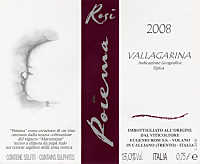
|
|
Poiema 2008 |
|
| Rosi (Trentino, Italy) | |
| Grapes: Marzemino | |
| Price: € 18.50 | Score: |
| Poiema shows an intense ruby red color and nuances of ruby red, little transparency. The nose reveals intense, clean, pleasing and refined aromas which start with hints of cherry, plum and blackberry followed by aromas of geranium, violet, black currant, raspberry, pomegranate, pink pepper and menthol. The mouth has good correspondence to the nose, a slightly tannic attack and however balanced by alcohol, good body, intense flavors, pleasing roundness. The finish is persistent with flavors of cherry, plum and blackberry. Poiema ages for 12 months in oak, cherry wood and chestnut wood casks. | |
| Food Match: Stuffed pasta, Stewed meat with mushrooms, Roasted white meat | |
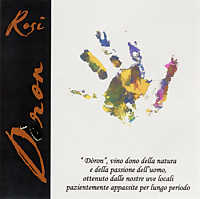
|
|
Dòron 2006 |
|
| Rosi (Trentino, Italy) | |
| Grapes: Marzemino | |
| Price: € 26.00 - 375ml | Score: |
| Dòron shows a deep ruby red color and nuances of ruby red, impenetrable to light. The nose reveals intense, clean, pleasing, refined and elegant aromas which start with hints of black cherry, blackberry and plum followed by aromas of dried violet, blueberry, chocolate, vanilla, mace, almond, pink pepper, tobacco and vanilla. The mouth has good correspondence to the nose, a sweet and slightly tannic attack, however balanced by alcohol, good body, intense flavors, agreeable. The finish is persistent with flavors of black cherry, blackberry and plum. Dòron is made from dried grapes and ages for about 15 months in barrique. | |
| Food Match: Fruit tarts, Hard cheese | |
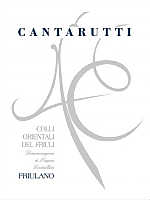
|
|
Colli Orientali del Friuli Friulano 2009 |
|
| Cantarutti Alfieri (Friuli Venezia Giulia, Italy) | |
| Grapes: Friulano | |
| Price: € 8.00 | Score: |
| Colli Orientali del Friuli Friulano shows a pale golden yellow color and nuances of straw yellow, very transparent. The nose reveals intense, clean, pleasing and refined aromas which start with hints of apple, plum and almond followed by aromas of pear, pineapple, hawthorn and broom. The mouth has good correspondence to the nose, a crisp attack and however balanced by alcohol, good body, intense flavors, agreeable. The finish is persistent with flavors of apple, plum and almond. Colli Orientali del Friuli Friulano ages in steel tanks. | |
| Food Match: Stuffed pasta with meat, Mushroom soups, Sauteed white meat, Cold cuts | |
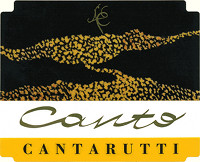
|
|
Colli Orientali del Friuli Bianco Canto 2009 |
|
| Cantarutti Alfieri (Friuli Venezia Giulia, Italy) | |
| Grapes: Friulano (50%), Pinot Blanc (25%), Sauvignon Blanc (25%) | |
| Price: € 7.50 | Score: |
| Colli Orientali del Friuli Bianco Canto shows an intense straw yellow color and nuances of straw yellow, very transparent. The nose denotes intense, clean, pleasing and refined aromas which start with hints of apple, peach and pear followed by aromas of citrus fruits, lychee, plum, broom, hawthorn and almond. The mouth has good correspondence to the nose, a crisp attack and however balanced by alcohol, good body, intense flavors, pleasing roundness. The finish is persistent with flavors of apple, peach and almond. Colli Orientali del Friuli Bianco Canto ages in steel tanks. | |
| Food Match: Stuffed pasta, Sauteed white meat, Stewed fish, Mushroom soups | |
|
||||||||
|
DiWineTaste Polls
|
| |||||||
Privacy Policy | |||||||


| Copyright © 2002-2024 Antonello Biancalana, DiWineTaste - All rights reserved |
| All rights reserved under international copyright conventions. No part of this publication and of this WEB site may be
reproduced or utilized in any form or by any means, electronic or mechanical, without permission in writing from DiWineTaste. |